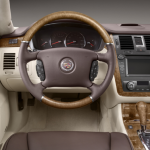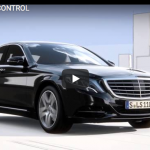
By Jim Gorzelany
Some might say it’s long overdue, but Lexus reportedly will be entering the burgeoning compact-luxury-SUV market for the 2015 model year with a brand-new model—said to be called the NX—that will be based on the Toyota RAV4’s architecture. Both a conventional NX 200t version, which would be powered by the brand’s first turbocharged 4-cylinder engine, and a NX 300h gas/electric hybrid model are expected to debut in world markets in late 2014 or early 2015, though it’s not clear from this standpoint which version the U.S. might receive first, or whether both will be introduced here simultaneously. Styling might resemble a cross between a taller version of Lexus’ CT 200h 4-door hybrid hatchback and a smaller take on the midsize RX crossover SUV. Either way, expect lively performance along with the requisite luxury features.
What It Is
The 2015 Lexus NX will be an all-new compact luxury crossover SUV likely to be based on the same platform that underpins the Toyota RAV4, which itself was redesigned for the 2013 model year. Front-wheel drive probably will be standard, with all-wheel optional for additional traction on wet or snowy roads. Two 5-passenger models reportedly will be available for worldwide sales, though it’s not clear which will reach dealer showrooms in the U.S. first, or whether both might bow simultaneously. Instead of a V6, the NX 200t is said to come powered by Lexus’ first-ever turbocharged 4-cylinder engine, while the NX 300h will pack a gas/electric hybrid 4-cylinder powertrain with similar horsepower but improved fuel economy. What’s more, a naturally aspirated 4-cylinder-powered version may join the line for a future model year as the value leader. As befits a Lexus, we expect the NX will deliver a smooth ride and capable handling, a tastefully designed and comfortable interior, and a slew of high-tech features that will include an advanced infotainment array with smartphone connectivity and many of the latest accident-avoidance systems.
Where It Fits
The 2015 Lexus NX would fit squarely in the hotly contested luxury-compact-crossover market and compete against an engaging array of models including the Acura RDX, Audi Q5, BMW X3, Infiniti QX50, Land Rover Range Rover Evoque, Mercedes-Benz GLK-Class, and Volvo XC60. This segment literally did not exist until the X3 debuted for 2004. Other models subsequently followed, beginning with the RDX for the 2007 model year. In addition to Lexus, Lincoln and Porsche are other latecomers to the field, reportedly readying their own entries for introduction during the 2014 or 2015 calendar years. Audi, BMW, and Mercedes-Benz have enjoyed such success with their compact models that they’re introducing even smaller crossovers—the X1, Q3, and GLA-Class, respectively—to cast a wider net for the sake of attracting upscale crossover-crazy consumers. Having additional smaller vehicles in their lineups also helps luxury automakers offset the sales of larger and more powerful (not to mention profitable) models to help meet stricter federal corporate average fuel-economy regulations that will be phased in during the coming years.
Engineering, Powertrains, and Features
While the 2015 NX is slated to be the upscale automaker’s first foray into the luxury-compact-SUV market, it will also represent another milestone for the brand, as it’s expected to be the first-ever Lexus model to be powered by a turbocharged engine. Other automakers have long leveraged turbo-4s as more fuel-efficient but no less powerful alternatives to 6-cylinder powerplants, though the luxury market has traditionally clung to the larger engines in this segment—at least as optional powerplants—because of their smoother operation and enhanced market perception. For example, Acura swapped a peppy turbo-4 for a V6 when it redesigned its RDX compact crossover for the 2013 model year and saw its sales increase substantially.
Lexus, however, doesn’t seem to be planning a V6 engine for the upcoming NX line, reportedly sticking instead with a 2.0-liter turbocharged 4-cylinder engine in the base NX 200t version. No word has yet been issued with regard to how much power that turbo-4 might generate, but based on other turbo-4s in the market we’d expect it to run in the low- to mid-200-horsepower range. We would assume it would include the latest engine technology, including direct fuel injection and variable valve timing, to help maximize both its output and fuel efficiency. This engine is expected to eventually supplant the 204-horsepower 2.5-liter V6 in the base version of the Lexus IS sport sedan.
Some reports suggest that a naturally aspirated 4-banger could eventually join the line as a price leader. That engine could be a version of the 176-horsepower 2.5-liter mill that powers the Toyota RAV4 upon which the NX will be based. We’d expect an automatic transmission to be the only available gearbox here, with 6 or as many as 8 forward speeds likely. Front drive should be the standard configuration, with a traction-enhancing all-wheel-drive system (probably borrowed from the RAV4) optional.
Meanwhile, the NX 300h version reportedly will use the hybrid powertrain from the Lexus ES 300h sedan, in which a 156-horsepower 2.5-liter 4-cylinder gasoline engine is augmented by an electric motor generator to deliver the equivalent of 200 horsepower. In the ES, fuel economy is estimated at 40 mpg city/39 mpg highway. This would be a so-called “full hybrid” in which the electric motor is capable of powering the vehicle solely at certain speeds for a few miles at a time. Power recovered through deceleration and braking would keep the car’s battery pack recharged without the need to be tethered to a wall outlet. As in the ES, the low-friction engine would utilize an advanced power management system and high compression ratio (12.5:1) to increase overall efficiency, with an electric water pump and electric power steering onboard to further help improve fuel economy. To that end, the gasoline engine should be able to shut down automatically while at idle to further help save gas. A gearless CVT (continuously variable transmission) automatic and a choice of front- or all-wheel drive should be included.
As in other Lexus models, we expect the NX to include a drive-mode selector that allows a motorist to choose between three modes: Normal, Eco (for maximum fuel economy), and Sport (to boost powertrain and steering responsiveness). The NX’s steering and suspension systems probably will be sprung a bit tighter than in the Toyota RAV4 for nominally improved handling response, though it’s not likely that Lexus will tune the vehicle so sporty that it becomes harsh riding in the process. The emphasis here probably will be focused more on delivering a comfortable ride than Porsche-like cornering abilities.
As for exterior styling, heavily disguised prototypes caught by spy photographers indicate that the 2015 NX could bear a familial resemblance to both the Lexus CT hatchback and RX crossover SUV, with the brand’s signature spindle-shaped grille up front, flanked by narrow angular headlamps that extend up and into the front fenders. Inside, expect the NX to likewise follow current Lexus design trends and feature a driver-focused cockpit with LED gauges. Likely, a large screen at the center of the dashboard will display information and control the audio system, navigation, and other features, probably via a joystick mounted on the center console between the front seats.
We expect that the 2015 Lexus NX would offer a long list of upscale features, either as standard or optional equipment, including heated/ventilated leather seats, pushbutton keyless entry/start, a power-operated liftgate, and an infotainment system with smartphone connectivity that enables users to access custom Pandora Internet radio stations, restaurant reviews, news, weather, traffic reports, and other data-based services. On the safety front, the NX probably will offer some of the latest collision-avoidance systems, including adaptive cruise control with forward-collision, blind-spot, and lane-departure warning systems.
Why It’s Being Built
The question here isn’t so much “Why is it being built?” as “Why did it take Lexus so long to bring a compact luxury crossover to market?” Most every mainstream luxury brand already offers a compact crossover, with Lincoln, Porsche, and even longtime SUV holdout Jaguar said to be joining the fray for the 2015 or 2016 model years.
According to the automotive forecasting company R.L. Polk and Associates, compact luxury SUV sales have skyrocketed by nearly fourfold over the past five years, with around 75,000 units being delivered in the first five months of 2013. Small crossovers currently account for more than one of every 10 luxury-model registrations in the U.S. (with luxury crossovers as a group comprising a third of the luxury market). Polk says that two of the eight currently available compact luxury crossovers—the Acura RDX and the Audi Q5—were their respective brands’ top-selling models over the first five months of 2013, with the Land Rover Evoque and Volvo XC60 being close runners-up.
What’s more, Lexus also has the potential to not only lure a younger demographic into the fold with the comparatively affordable NX, but satisfy the expectations of affluent empty-nesters looking to downsize their rides without sacrificing elements of performance and luxury. Adding another line of reasonably fuel-efficient vehicles will also help Lexus and its overseers at Toyota meet higher federal fuel-economy standards that are being phased in over the coming years (which, in turn, enables the automaker to sell less-efficient yet costlier and more profitable models).
What It Might Cost
We expect the 2015 Lexus NX 200h with the turbo-4 engine and front drive to start in the low-$30,000 range, with the NX 300h hybrid perhaps reaching into the mid-$40,000s for a fully loaded version.
Test Drive: 2018 Lexus NX 300h
CG Says:
This is as close to an automatic move as it gets in the new-car business. Compact crossovers have fast become popular items among luxury automakers’ lineups, with even holdouts such as Porsche, Lincoln, and Jaguar planning small, upscale SUVs of their own for release within a year or two. Some, including Audi, BMW, and Mercedes, are even adding a second smaller model to their portfolios to help attract even younger and/or more price-sensitive buyers. If anything, Lexus executives might worry that they’ve waited too long to develop the NX, with the market perhaps soon reaching the saturation point for small, luxury-minded crossover SUVs.
Having a turbocharged 4-cylinder as the standard engine enables Lexus to maintain both acceptable levels of performance and good fuel economy, though we can’t help but wonder if the brand is missing the proverbial boat by not offering a V6 engine—particularly Toyota’s exceptional 3.5-liter V6—as an alternative for less fuel economy-conscious buyers seeking smoother and quicker operation. Acura abandoned the previous turbo-4 engine in the RDX crossover last fall with the model’s latest redesign in favor of an efficient V6, and sales increased by a whopping 96 percent over the first six months of 2013.
Unless gas prices hit or exceed the $5/gallon mark, we don’t expect the hybrid-powered version to account for more than perhaps 25 percent of NX’s sales, especially if it starts at around $40,000, which would be dangerously close to the price of a conventionally powered RX 350 midsize crossover, which offers more interior room and a 270-horsepower V6 engine. It also would be much more expensive than the wagon-like Toyota Prius v, which likely would deliver similar or better fuel economy. The 2013 Prius v starts at $26,650 and is rated at 44 mpg city/40 mpg highway.



